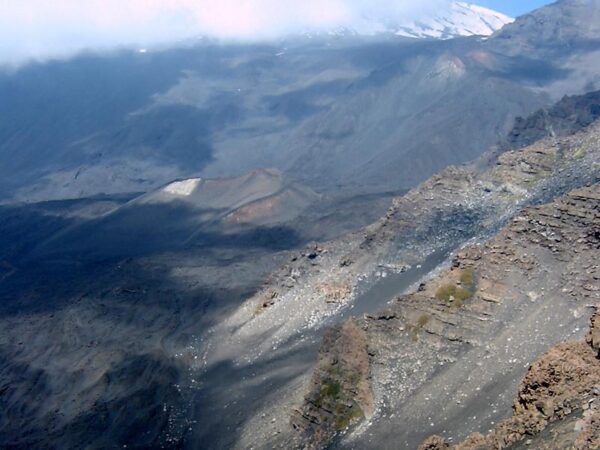Guides and tough, brave hikers already knew it. Many people are just discovering about it right now, because of the new eruption of this May 2022. The mini volcanic event that started from the South East Crater of Mount Etna is pouring a stream of lava into the Valle del Leone (the Valley of the Lion), and everybody is now looking at the maps. Where is this place with such a romantic and weird name? Why “the Lion”? Are there lions on Mount Etna? Were they there in the past? The explanation is much easier than it seems.
Etna and the three valleys
Valle del Bove (the Valley of the Bull, see video here) is the most famous of all. They name it every time there is a new eruption, the media tell about it, show it from above . This large valley was formed by a series of collapsing and landslides 65,000 years ago. The former top part of Etna broke into pieces and fell down, creating such a huge space. Since then, the valley collects the lava streams from the many eruptions of this volcano. It is definitely the “super moat” that protects the eastern towns from any danger!
But what many do not know is that Valle del Bove is only “the middle part” of a series of three valleys. The other two are smaller and are located above and below the immense esplanade. Val Calanna once stood below Valle del Bove. It was a small basin of woods and cultivated fields, full of greenery and flowers. A sight that, in springtime, left you breathless. Destination of many campsites, in the past, it was sadly canceled by the long lateral eruption of 1991-1993, whose lava flows almost completely filled it.
Upstream of Valle del Bove, there is the Valle del Leone. It is located right at the foot of the summit craters and almost completely surrounded by the ridge formed by Monte Nero delle Concazze, Monti Sartorius, Pizzi Deneri. Different from the romantic Val Calanna, and from Valle del Bove with its multiple panoramas, Valle del Leone is a real desert of red and black rock. Yet it has this name that fascinates and intrigues.
Valley of the Lion, origin of the name
 photo Parcoetna it
photo Parcoetna it
No, there were no lions on Etna. Perhaps – a few million years ago – they existed in Sicily, but there is no evidence of this. On Etna, anyway, there weren’t any. Cows and bulls, the “bove” from which the other valley takes its name, they do exist still today, instead. But … why are we talking about a lion, here?
Many hypotheses have always followed one another over the centuries. The two most probable relate to the panorama you can admire from the valley and to the poetic power of the Sicilian language. From Valle del Leone you can admire the peaks of the lava ridge above, which – especially when it is backlit – appear as a gigantic lion mane. Hence the reference to the well-known African animal.
Alternatively, it is likely that the name Valle del Leone is just the italianization of the Sicilian term “vadduni”. A “vadduni” is a large valley, very deep and long, which usually surrounds a river’s bed. In Sicily there are numerous “vadduni” scattered throughout the territory. And it would not be surprising if, admiring this depression from above, someone also renamed it “U Vadduni”. From “vadduni” to the Italian translation of “vallone” to “val leone” the passage is quick and very logical.
Excursion to the Valley of the Lion
Tourist excursions often skirt the Valle del Leone. Only rarely do they enter it to cross it. The path is already very hard to reach it, so only a “taste” of it is offered to brave hikers.
Usually excursions start from Piano Provenzana, where the parking lots and services of the Etna Nord base are located. They continue on foot for many kilometers – more than 10 – to get close to the North East crater. There you take a break and then descend, passing precisely on the edge of Valle del Leone. From above you can admire it from the Pizzi Deneri observatory or from Monte Nero delle Concazze. From a distance, on the opposite side of Valle del Bove, it can be seen by looking out over the viewpoints of Monte Zoccolaro and Schiena dell’Asino.
Valle del Leone could also be reached by crossing Valle del Bove. But this is a hike for real tough and well trained hikers. And often for “lone wolves”, too. Few people venture out, also because it is necessary to know the volcano very well and understand every slightest sign of danger. Of course, even normal tourist excursions are subject to sudden changes and stops, if there is not the absolute certainty of safety while crossing these places. Remember! You are very close to the lively craters of the most active volcano in Europe! (the photo above the title by G.Musumeci)